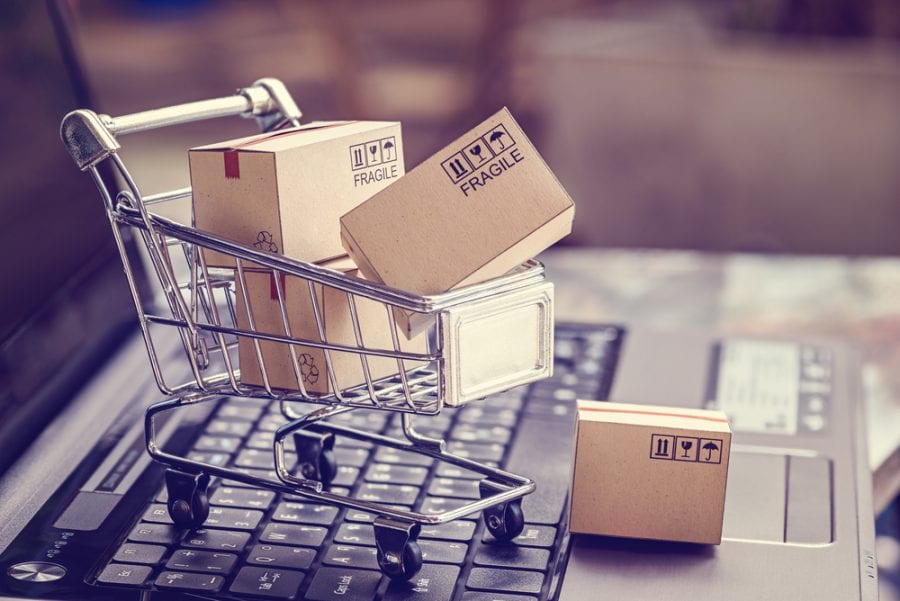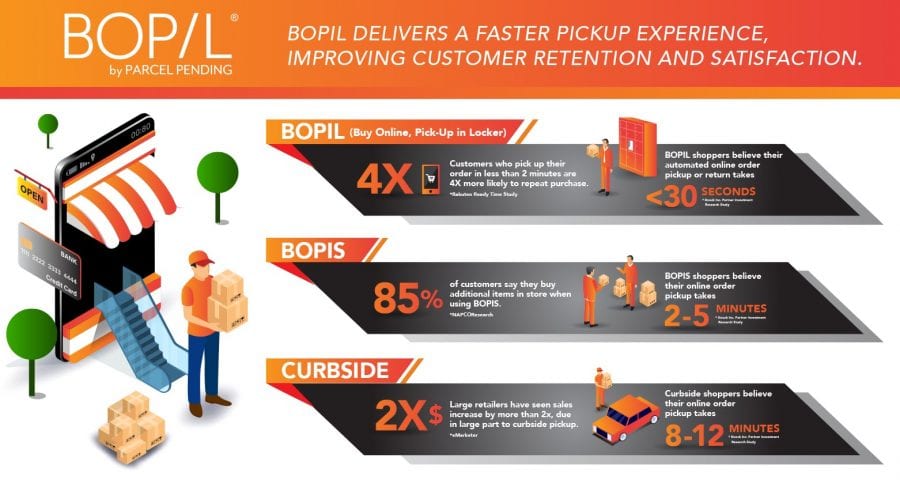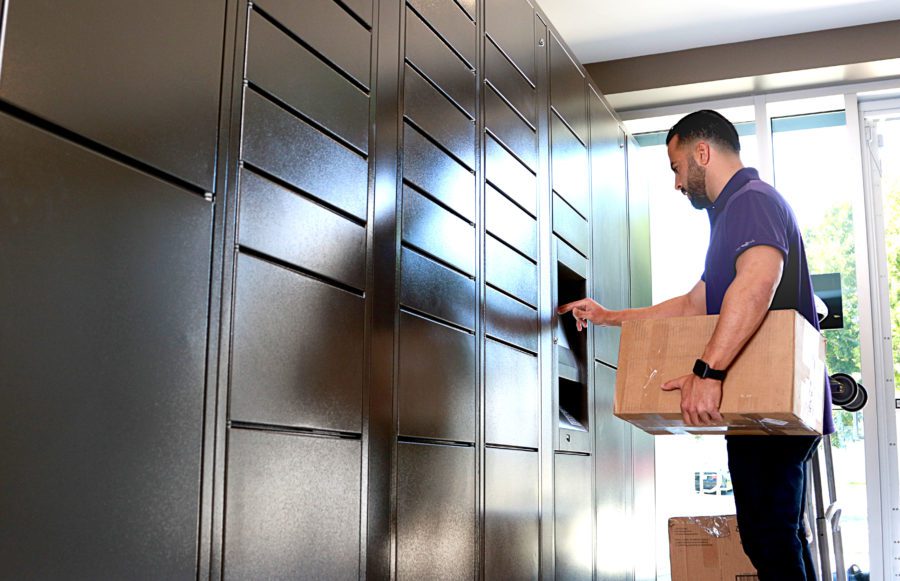
Retail
Click & Collect: Curbside Pick Up vs. Retail Parcel Lockers
Written by: Jordan Byrd
5 Min Read
Published: April 2, 2021
Updated: August 7, 2025
Updated Jan 28, 2024
Retail shopping has forever changed with the exponential growth of online shopping and the evolution of click and collect shopping during the COVID-19 pandemic. After all, e-commerce’s share of all retail sales has now hit a jaw-dropping 23% during the third quarter of 2020.1 Retail innovation, such as improved technology and order fulfillment options, have revolutionized the way consumers shop.
One of the most popular trends in retail innovation is “click and collect”. Click and collect includes both curbside pickup as well as retail parcel lockers. However, there are key differences between the two.
| Curbside Pickup | Retail Parcel Lockers | |
| Boosts Safety with Social Distancing | Yes | Yes |
| Saves Retailer Last-Mile Costs | Yes | Yes |
| Contactless Returns | Limited availability, substantial wait time | Customers can easily process a return within 2 minutes |
| Spurs Impulse Purchases | No | 61% of customers make an incremental purchase |
| Retailer Labor Cost | Substantial | Minimal |
| Perceived Wait Time for Customers | 8-12 minutes | Less than 30 seconds |
| Sales Impact & Loyalty | 2x sales increases (approximately double) | Customers are 4x more likely to purchase again if wait is under 2 minutes |
Curbside Collection Process
Curbside collection for a click & collect order has improved tremendously since first introduced during the start of the pandemic in March of 2020. In those early days, customers would arrive at a retailer’s parking lot, phone the local store, and then wait, hope (and pray) that the store associate would accurately deliver them the correct items. Today, the click & collect service offered by many retailers is markedly improved with online tracking apps and designated pickup locations. You can even select a preferred store to streamline pickup of your online purchase(s).
Here’s how curbside collection works:
- A customer places an online order either through the website or mobile app.
- Using real-time inventory information, retailers’ sites inform customers about available store pickup options.
- The customer selects a pickup point and time or a “notify when ready” option.
- A store associate picks and packs the order.
- The customer is provided a collection notification via a confirmation email and/or SMS that their order is ready for pickup at a nearby physical store.
- The customer drives to their chosen store and awaits delivery of their order. Using the retailer’s proprietary app such as Walmart or Target, the customer alerts the store that they are en route. Note: Customers believe this fulfillment process takes between 8-12 minutes.
- A store associate (usually from the customer care team) delivers the order to the customer’s car after being provided identification (such as a photo ID or driver’s license) or a QR code. Note: Limited curbside support for returns; customers are normally required to enter the store or ship the order back themselves.
Retrieving Orders with Retail Parcel Lockers
- Customers place an online order either through the website or mobile app.
- Using real-time inventory information, retailers’ sites inform customers about available store pickup location options.
- A store associate picks and packs the order.
- A store associate securely places the delivery into the locker.
- Customers are notified that their order is ready for pick-up.
- Customers come into their designated physical store and collect their order from the collection lockers at their convenience. Note: order pickup with retail parcel lockers typically takes less than 30 seconds.
- Lockers also support contact-free returns, a process that also takes less than 30 seconds for a customer to complete. That means customers don’t need to worry about the hassle of checking store opening hours or waiting in long lines to make a return.
The Key Advantages of Retail Parcel Lockers
Click & collect service options solve the problem of last-mile delivery. In fact, Target estimates that it costs an average of 40% less when shoppers choose a BOPIS option, such as picking up their click & collect order curbside or in stores, compared with the average shipping costs from a warehouse.
- Incremental Purchases and Sales – 61% of customers make an incremental purchase just by virtue of entering the store! And, customers whose wait times are two minutes and under (like retail parcel lockers), are four times more likely to purchase again.
- Lower Labor Costs – Both curbside and retail parcel lockers require retail employees to pick and pack the order. The key difference, however, is that once the order is placed into a locker, the labor costs decrease significantly with retail parcel lockers. Retailers that employ parcel lockers saved an average of 45 hours per month versus managing BOPIS orders.2
- Fast and Easy Returns – If customers collect their order from a locker and decide not to keep it for whatever reason, they are able to communicate with the retailer and place it back in the locker within two minutes for an easy return. Retail lockers are a delivery option that ensure seamless returns management, and are regarded as one of the most important omnichannel trends for 2022 and beyond. By contrast, curbside collection often requires customers to enter the store, perhaps stand in line, and deal with an employee to issue a return/refund. And curbside returns (if available), take nearly as long as curbside pick-up. Alternatively, customers may return the item shipping back to the retailer, often at their own expense.
- Better Customer Experience – The retail customer experience is more important than ever and has proven itself to be critical for ensuring repeat business. Since it only takes an average of only two minutes to retrieve an order using parcel lockers, customers rate their shopping experience higher. 73% of consumers say a good experience is key in influencing their brand loyalties and loyal customers are five times more likely to purchase again.3,4
Overwhelmingly, retail parcel lockers wins the competition for customers’ hearts and wallets. Talk to a customer service representative today about how your chosen store can join major retailers just like Lowe’s that have installed Parcel Pending’s locker pickup solutions to boost sales and loyalty.
If you’re interested in learning more about retail insights, including the latest eCommerce predictions, check out our other retail blog posts.
Sources:
- Kapner, Suzanne. The Wall Street Journal. Covid-19 Rewrote the Rules of Shopping. What’s Next?. (2021, March 12). https://www.wsj.com/articles/covid-19-rewrote-the-rules-of-shopping-what-is-next-11615561232
- Reidel, Kate. Parcel Pending. Omnichannel Retail Strategy: Bringing Online Shoppers to Brick & Mortar Stores. (2020, June 1). https://www.parcelpending.com/en-usblog/omnichannel-retail-strategy-bringing-online-shoppers-to-brick-mortar-stores/
- Clark, David & Puthiyamadam, Tom. PWC. Experience is Everything. Get it right. (2017). https://www.pwc.com/future-of-cx
- Dorsey, Moira. Qualtrics XM Institute. Research Recap: ROI of Customer Experience, 2020. (2020, September 17). https://www.xminstitute.com/blog/research-recap-2020-roi-cx/



